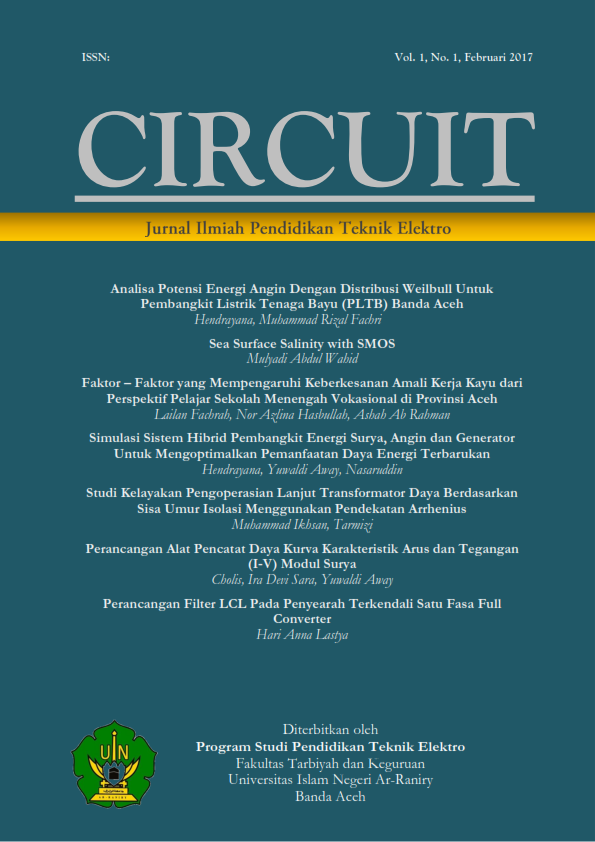Penentuan Nilai Hambatan dan Hambatan Jenis pada Arang Batok Kelapa dan Arang Kulit Pisang dengan Metode Eksperimen
DOI:
https://doi.org/10.22373/crc.v4i2.6510Keywords:
coconut shell charcoal, cassava peel charcoal, carbon film resistor, resistance, specific resistanceAbstract
Due to an application of coconut shell and cassava peel-based charcoal as an alternative material in carbon film resistors, the purpose of this study is to determine the value of both resistance and specific resistance of those materials. The fresh coconut shell and cassava peel were dried under sunlight prior to charcoal production through pyrolysis. The resulted charcoals were then grounded into powder and filtered. After that, the fine materials were inserted into a straw with a wide area of 6,07 x 10-7 m2and 1,2 x 10-4 m2 and the length of 0,03 m and 0,04 m. The results obtained that the resistance values of the coconut shell and cassava skin charcoal were 5 104 Ω to 11 104 Ω and 3 104Ω to 5 104 Ω, respectively. While the specific resistance values of those charcoals were 1,133 Ωm to 2,34 × 102 Ωm and 0,758 Ωm to 1,28 102 Ωm, respectively. In conclusion, both resistance and specific resistance values of coconut shell charcoal seem to be relatively higher than the coconut shell charcoal.
References
A. K., Bledzki, A. A. Maimun, J. Volk (2010).Barley husk and Coconut Shell reinforced polypropylene composites: The effect of fibre physical, chemical and surface properties. Composites Science and Technology, Vol. 70, 840-846.
Budi, Esmar (2011). Tinjauan Proses Pembentukan dan Penggunaan Kelapa Sebagai Bahan Bakar. Jurnal Fisika, 14 (4B), 2.
Fitri, Wida Susanti (2018). Perancangan dan Pembuatan Modul Pratikum Elektronika Dasar, Malang: Teknik Elektro Universitas Muhammaddiyah Malang, Hlm. 5.
Gilar S. Pambayun dkk (2013). Pembuatan Karbon Aktif Dari Arang Tempurung Kelapa Dengan Aktivator Zncl2 Dan Na2co3 Sebagai Adsorben Untuk Mengurangi Kadar Fenol Dalam Air Limbah. Jurnal teknik Pomits, 2(1), 116-120.
I, Suherman, Melati, (2009). Pembuatan Karbon Aktif Dari Limbah Kulit Singkong, UKM Tapioka Kabupaten Pati, Seminar Nasional Teknik Kimia Indonesia, Bandung, Hlm 2.
Maulinda, Leni, Nazrul ZA, Dara Nurfika Sari (2015). Pemanfaatan Kulit SIngkong sebagai Bahan Baku Karbon Aktif. Jurnal Teknologi Kimia Unimal, 4(2), 11-19.
Putri, Karimah (2014). Sistem Kontrol Otomatis menggunakan sensor cahaya dan sensor air hujan pada bangun rumah Tinggal, Semarang: POLITEKNIK Negeri Semarang, Hlm 19.
Salim, Noor Nanang Saiful Rizal, Ricky Vihantara (2018). Komposisi Efektif Batok Kelapa sebagai bahan karbon aktif untuk meningkatkan kualitas air tanah di kawasan perkotaan. Media Komunikasi Teknik Sipil. 24 (1), 87-95.
Sofiana, Ana, Sujarwata, dan Ian Yulianti, (2017). Identifikasi Nilai Hambat Jenis Arang Tempurung Kelapa dan Arang Kayu Mangrove sebagai Bahan Alternatif Pengganti Resistor Film Karbon, Unnes Physics Journal, 6 (1), 1-6.
Downloads
Published
Issue
Section
License
Authors who publish in this journal agree to the following terms:
- Authors retain copyright and grant the journal right of first publication with the work simultaneously licensed under a Creative Commons Attribution License that allows others to share the work with an acknowledgement of the work's authorship and initial publication in this journal.
The Journal uses license CC-BY-SA or an equivalent license as the optimal license for the publication, distribution, use, and reuse of scholarly works.
Authors are able to enter into separate, additional contractual arrangements for the non-exclusive distribution of the journal's published version of the work (e.g., post it to an institutional repository or publish it in a book), with an acknowledgement of its initial publication in this journal.
- Authors are permitted and encouraged to post their work online (e.g., in institutional repositories or on their website) prior to and during the submission process, as it can lead to productive exchanges, as well as earlier and greater citation of published work (See The Effect of Open Access).

